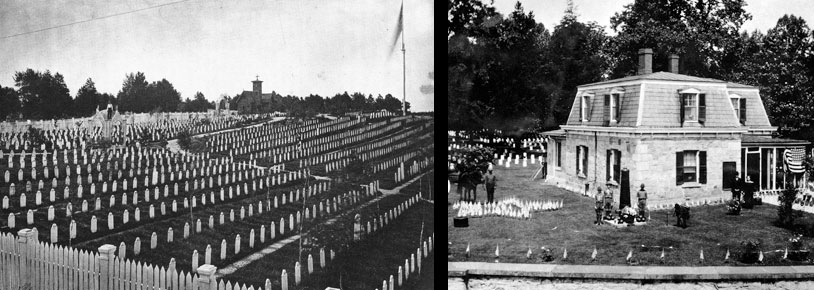

Civil War Era National Cemeteries: Honoring Those Who Served
Beverly National Cemetery
Beverly, New Jersey
 |
Superintendent's Lodge, Beverly National Cemetery Courtesy of the Department of Veterans Affairs, National Cemetery Administration, History Program |
In 1864, at the height of the Civil War, wounded soldiers crowded Philadelphia’s military hospitals. To make room for more critically injured patients, a convalescent hospital was established in Beverly, New Jersey, 20 miles north of Philadelphia on the east bank of the Delaware River. The War Department converted a rope factory in to a facility to care for soldiers well enough not to need full hospital care yet not fit to return to active duty.
The river steamer John A. Warner transported soldiers from Philadelphia to Beverly’s hospital. The steamer sounded its whistle in advance of its arrival at the town’s wharf, signaling the town residents who brought wagons to transport the patients to the hospital. As the procession began, church bells pealed and Beverly residents lined the streets offering coffee and food to the soldiers.
Doctors at the convalescent hospital performed surgeries as necessary, including amputations. Local tradition holds that amputated limbs were buried in a vacant one-acre lot owned by Christian Weyman. Weyman conveyed the property to the U.S. government in August 1864, under conditions that the acre be properly enclosed and serve as a burial ground for U.S. servicemen. Officially established as a national cemetery, the first burial took place on August 29, 1864.
By the close of the war, 147 Union soldiers, all but 10 identified, were buried at the Beverly National Cemetery. A rubble stone wall originally enclosed the small cemetery. Starting in the 1930s, expansions to the cemetery necessitated the removal of the 1877 stone wall. Today, wrought-iron fencing stands along Bridgeboro Road, while the remainder of the property is enclosed by modern fencing. In 1949, a new wider main entrance gate on Bridgeboro Road allowed for the passage of motorized vehicles. Service gates are located along Green Street on the cemetery’s south side.
 |
Beverly National Cemetery Courtesy of the Department of Veterans Affairs, National Cemetery Administration, History Program |
The cemetery’s rostrum stands east of the lodge. Constructed in 1937, the rostrum resembles an open-air Greek temple. The structure, primarily constructed of limestone, consists of a raised rectangular platform with three Tuscan columns rising from each corner. The columns support a simple entablature with pediments at either end. A seamed copper roof covers the rostrum. Limestone benches, arranged in a shallow arc, form a small amphitheater around the rostrum.
Other structures located on the cemetery’s grounds include a 1957 brick administration building, a brick and concrete garage built in 1941, and a service building with restrooms constructed in 1936.
In 1875, the state of New Jersey erected a 70-foot-tall monument to Union soldiers. Deterioration of the monument became evident in 1950 and led to its deconstruction in 1951. The monument was stored on site until 1953 when the local American Legion Post requested the statue of the soldier that had crowned the monument. The statue, along with part of the intricately carved base, now stands at the local American Legion Post at 700 Melbourne Street in Beverly, a few blocks north of the cemetery.
Beverly National Cemetery is the final resting place for Medal of Honor recipients, the nation’s highest military decoration, given for “conspicuous gallantry and intrepidity at the risk of his life above and beyond the call of duty.”
Seven unknown Revolutionary War soldiers lay in the cemetery’s Section F. Initially buried in Camden, their remains were transferred to Beverly National Cemetery in 1955.
| Plan your visit |
Beverly National Cemetery is located at 916 Bridgeboro Rd. in Beverly, NJ. The cemetery is open for visitation daily from 8:00am to sunset; however, no cemetery staff is present on site. The administrative office is located at the Washington Crossing National Cemetery in Newtown, PA, and is open Monday to Friday from 8:00am to 4:30pm. It is closed on all Federal holidays except for Memorial Day and Veterans Day. For more information, please contact the cemetery office at 215-504-5610, or see the Department of Veterans Affairs website. While visiting, be mindful that our national cemeteries are hallowed ground. Be respectful to all of our nation’s fallen soldiers and their families. Additional cemetery policies may be posted on site. Beverly National Cemetery was photographed to the standards established by the National Park Service’s Historic American Landscapes Survey. |